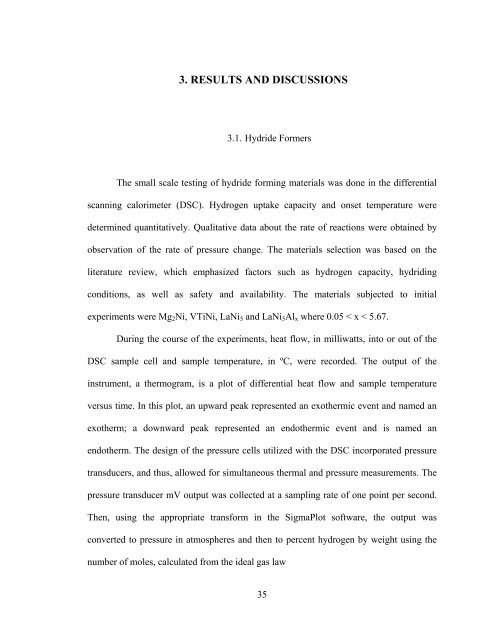Create successful ePaper yourself
Turn your PDF publications into a flip-book with our unique Google optimized e-Paper software.
3. RESULTS AND DISCUSSIONS<br />
3.1. Hydride Formers<br />
The small scale testing of hydride forming materials was done in the differential<br />
scanning calorimeter (DSC). Hydrogen uptake capacity and onset temperature were<br />
determined quantitatively. Qualitative data about the rate of reactions were obtained by<br />
observation of the rate of pressure change. The materials selection was based on the<br />
literature review, which emphasized factors such as hydrogen capacity, hydriding<br />
conditions, as well as safety and availability. The materials subjected to initial<br />
experiments were Mg 2 Ni, VTiNi, LaNi 5 and LaNi 5 Al x where 0.05 < x < 5.67.<br />
During the course of the experiments, heat flow, in milliwatts, into or out of the<br />
DSC sample cell and sample temperature, in ºC, were recorded. The output of the<br />
instrument, a thermogram, is a plot of differential heat flow and sample temperature<br />
versus time. In this plot, an upward peak represented an exothermic event and named an<br />
exotherm; a downward peak represented an endothermic event and is named an<br />
endotherm. The design of the pressure cells utilized with the DSC incorporated pressure<br />
transducers, and thus, allowed for simultaneous thermal and pressure measurements. The<br />
pressure transducer mV output was collected at a sampling rate of one point per second.<br />
Then, using the appropriate transform in the SigmaPlot software, the output was<br />
converted to pressure in atmospheres and then to percent hydrogen by weight using the<br />
number of moles, calculated from the ideal gas law<br />
35



